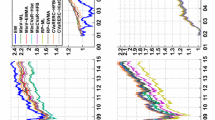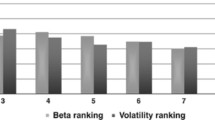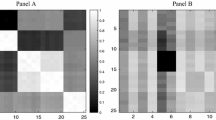Abstract
How to construct effective investment strategies is a core issue for modern finance. In this paper, we investigate the benefits of various models by rebalancing portfolios using the daily stock return data in Taiwan. We further consider investment constraints in portfolios to ensure the feasibility of their applications. Using five performance criteria, we find the risk models, particularly the CVaR, yield higher ex ante and ex post performance than a naïve buy-and-hold portfolio. The two-stage regressions show that high return benefits are associated with a bear market while high reduction in risk is positively related to high volatility. Though VaR is regarded as a standard model applied in the real world, our findings suggest that CVaR can serve as a good alternative.









Similar content being viewed by others
Notes
Coherent risk measure means a risk measure have four desired properties: monotonicity, sub-additivity, homogeneity, and translational invariance. See Rockafellar et al. (2006) for detailed discussion.
References
Angel JJ, Christophe SE, Ferri MG (2003) A close look at short selling on Nasdaq. Financ Anal J 59:66–74
Angelelli E, Mansini R, Speranza MG (2008) A comparison of MAD and CVaR models with real features. J Bank Finance 32:1188–1197
Benati S, Rizzi R (2007) A mixed integer linear programming formulation of the optimal mean/value-at-risk portfolio problem. Eur J Oper Res 176:423–434
Carrieri F, Chaieb I, Errunza V (2013) Do implicit barriers matter for globalization? Rev Financ Stud 26:1694–1739
Chang CT (2005) A modified goal programming approach for the mean-absolute deviation portfolio optimization model. Appl Math Comput 171:567–572
Chiou WP (2008) Who benefits more from international diversification? J Int Financ Mark Inst Money 18:466–482
De Roon FA, Nijman TE, Werker BJ (2001) Testing for mean–variance spanning with short sales constraints and transaction costs: the case of emerging markets. J Finance 56:721–742
DeMiguel V, Garlappi L, Uppal R (2009) Optimal versus naive diversification: how inefficient is the 1/n portfolio strategy? Rev Financ Stud 22:1915–1953
Elton EJ, Gruber MJ, Brown SJ, Goetzmann WN (2007) Modern portfolio theory and investment analysis, 7th edn. Wiley, New Jersey
Frankfurter G, Phillips H, Faulk G (1999) The ex post performance of four portfolio selection algorithms. Rev Quant Financ Acc 13:347–366
Gotoh J, Takeda A (2012) Minimizing loss probability bounds for portfolio selection. Eur J Oper Res 217:371–380
Green RC, Hollifield B (1992) When will mean–variance efficient portfolios be well diversified? J Finance 47:1785–1809
Grootveld H, Hallerbach W (1999) Variance vs. downside risk: is there really that much difference? Eur J Oper Res 114:304–319
Hsu C, Huang C, Chiou W (2012) Effectiveness of copula-extreme value theory in estimating value-at-risk: empirical evidence from Asian emerging markets. Rev Quant Financ Acc 39:447–468
Jagannathan R, Ma TS (2003) Risk reduction in large portfolios: why imposing the wrong constraints helps. J Finance 58:1651–1683
Jorion P (2000) Value-at-Risk: the new benchmark for managing financial risk. McGraw-Hill, New York
Konno H, Yamazaki H (1991) Mean-absolute deviation portfolio optimization model and its applications to Tokyo stock market. Manag Sci 37:519–531
Kwan CCY (1997) Portfolio selection under institutional procedures for short selling: normative and market-equilibrium considerations. J Bank Finance 21:369–391
Li K, Sarkar A, Wang Z (2003) Diversification benefits of emerging markets subject to portfolio constraints. J Empir Finance 10:57–80
Lin CC (2009) Comments on ‘A mixed integer linear programming formulation of the optimal mean/value-at-risk portfolio problem. Eur J Oper Res 194:339–341
Ma C, Wong WK (2010) Stochastic dominance and risk measure: a decision-theoretic foundation for VaR and C-VaR. Eur J Oper Res 207:927–935
Markowitz H (1952) Portfolio selection. J Finance 7:77–91
Mausser H, Rosen D (1999) Beyond VaR: from measuring risk to managing risk. ALGO Res Q 1:5–20
Ogryczak W, Ruszczyński A (2002) Dual stochastic dominance and related mean risk models. SIAM J Optim 13:60–78
Rockafellar RT (1970) Convex analysis. Princeton mathematics 28. Princeton University Press, Princeton
Rockafellar RT, Uryasev S (2000) Optimization of conditional value-at-risk. J Risk 2:21–41
Rockafellar RT, Uryasev S (2002) Conditional value-at-risk for general loss distribution. J Bank Finance 26:1443–1471
Rockafellar RT, Uryasev S, Zabarankin M (2006) Generalized deviations in risk analysis. Finance Stoch 10:51–74
Simaan Y (1997) Estimation risk in portfolio selection: the mean–variance model versus the mean-absolute-deviation model. Manag Sci 43:1437–1446
Speranza MG (1993) Linear programming model for portfolio optimization. Finance 14:107–123
Verchera E, Bermudez JD, Segura JV (2007) Fuzzy portfolio optimization under downside risk measures. Fuzzy Sets Syst 158:769–782
White JA (1990) More institutional investors selling short: but tactic is part of wider strategy. Wall Street J 7:742–747
Woodside-Oriakhi M, Lucas C, Beasley J (2013) Portfolio rebalancing with an investment horizon and transaction costs. Omega 41:406–420
Yu JR, Lee WY (2011) Portfolio rebalancing model using multiple criteria. Eur J Oper Res 209:166–175
Yu J, Lee W, Chiou W (2014) Diversified portfolios with different entropy measures. Appl Math Comput 241:47–63
Yu JR, Chiou W, Mu D (2015) A linearized value-at-risk model with transaction costs and short selling. Eur J Oper Res 247:872–878
Acknowledgments
The author would like to thank Cheng-Few Lee (the editor), anonymous referees, Ted Moorman, and participants at the Financial Management Association Annual Meeting in Nashville for helpful comments and suggestions. The usual disclaimer applies.
Author information
Authors and Affiliations
Corresponding author
Rights and permissions
About this article
Cite this article
Yu, JR., Chiou, WJ.P. & Yang, JH. Diversification benefits of risk portfolio models: a case of Taiwan’s stock market. Rev Quant Finan Acc 48, 467–502 (2017). https://doi.org/10.1007/s11156-016-0558-0
Published:
Issue Date:
DOI: https://doi.org/10.1007/s11156-016-0558-0




